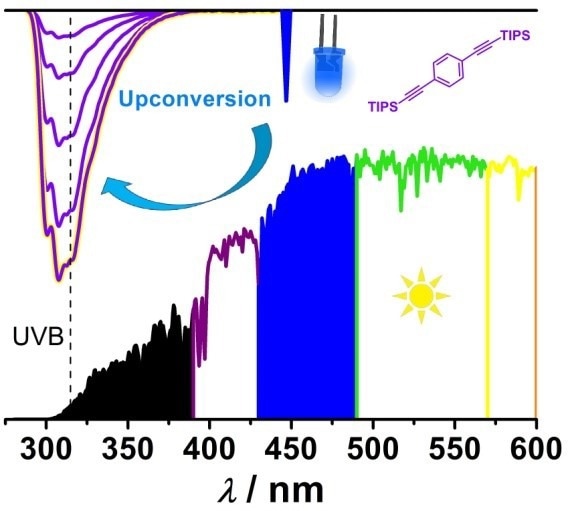Reviewed by Alex SmithDec 2 2022
Numerous photochemical processes depend on UV light from ineffective or unsafe light sources that the LED technology would find hard to substitute due to certain technical aspects.
 Conversion of readily available blue light into high-energy UV photons that cannot be provided by sunlight. Image Credit: Ill./©: Christoph Kerzig
Conversion of readily available blue light into high-energy UV photons that cannot be provided by sunlight. Image Credit: Ill./©: Christoph Kerzig
An international group of researchers guided by Professor Christoph Kerzig of Johannes Gutenberg University Mainz in Germany and Professor Nobuhiro Yanai of Kyushu University in Japan has recently created the first molecular platform for turning blue light into high-energy UV photons with wavelengths under 315 nm.
These photons in the commonly called UVB range are vital for many photochemical processes concerning disinfection, light-to-energy conversion, or even wastewater treatment uses. However, sunlight cannot offer UVB photons, and their synthetic generation usually depends on mercury lamps or other extremely inefficient substitutes.
The new results reveal that a metal-free photon upconversion (UC) system can change easily available visible light into UVB photons. Hence, this innovation can be looked at as a more eco-friendly method. Preliminary mercury-free applications have already been established in the lab.
Collaborative Research with a Long Tradition
The two research teams began working on UC many years ago. UC is a process wherein the absorption of two photons of lower energy results in the release of one photon of higher energy. This method has been formulated to boost the efficiency of solar cells, mostly by changing low-energy photons in the infrared region.
In contrast, highly energetic UV photons are within reach when blue light is used as the energy source.
Christoph Kerzig, Study Lead Author and Professor, Department of Chemistry, Johannes Gutenberg University of Mainz
Customized molecules have been developed in Mainz and characterized using a new large-scale laser device newly deployed in the Kerzig group. Moreover, special spectroscopic methods in the laboratory of Professor Nobuhiro Yanai have been applied to the UC system to comprehend its performance fully.
While the present article signifies the first partnership between the Kerzig and Yanai groups, the chemistry departments of their universities have a long-standing student exchange program. This unique partnership will further reinforce the network between Kyushu and Mainz.
Development of Reusable Upconversion Materials
The researchers used an existing blue LED as light source and made use of the generated UV light for the cleavage of robust chemical bonds that would otherwise necessitate extreme reaction circumstances.
Furthermore, using the laser installation in Mainz, PhD student Till Zähringer succeeded in observing all intermediates in the intricate energy conversion mechanism.
Our next goal is to develop reusable materials for versatile applications.
Nobuhiro Yanai, Study Lead Author and Professor, Kyushu University
His team in Kyushu is famous for the creation of photoactive materials. The mixture of photochemistry, materials science, and photocatalysis in the context of the Kyushu-Mainz partnership will facilitate the way for this indefinite goal.
The outcomes of these joint research activities have been illustrated in Angewandte Chemie, classified as a Very Important Paper (VIP) as a result of outstanding evaluations by scientific reviewers. The German Research Foundation (DFG) is funding this research via two separate research grants worth nearly EUR 500,000.
Additionally, the Chemical Industry Funds and the German Federal Environment Foundation backed this project via fellowships to Till Zähringer and Christoph Kerzig. This study is supported in part by Grants-in-Aid for Scientific Research from the Japan Society for the Promotion of Science.
Journal Reference:
Zähringer, T. J. B., et al. (2022) Blue-to-UVB Upconversion, Solvent Sensitization and Challenging Bond Activation Enabled by a Benzene-Based Annihilator. Angewandte Chemie. doi.org/10.1002/anie.202215340.